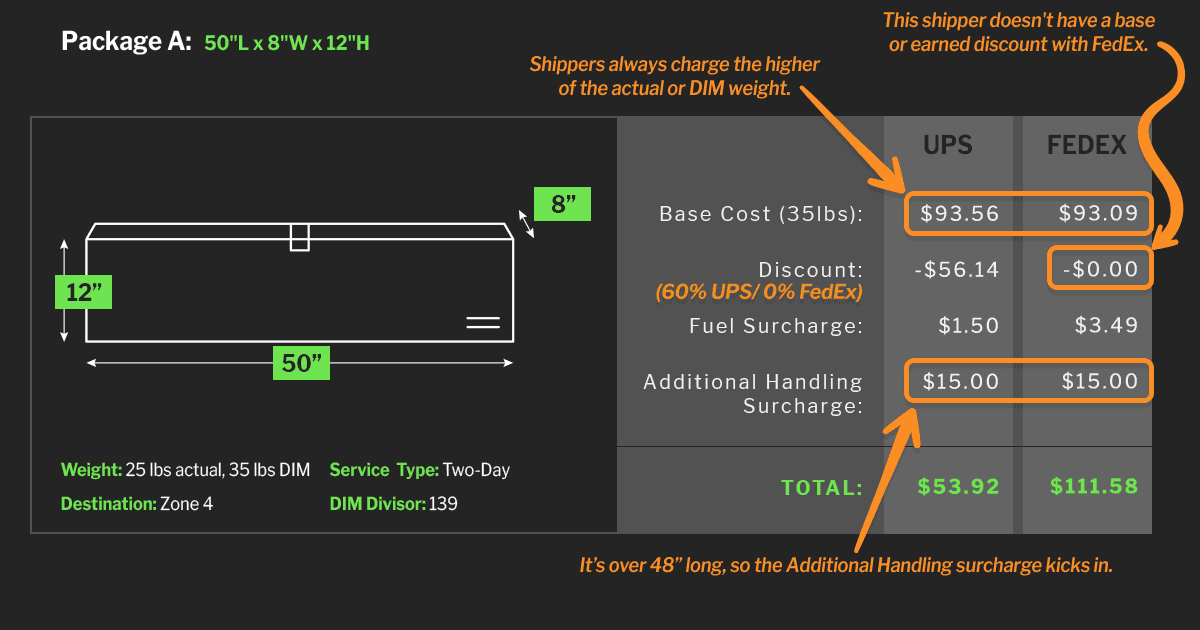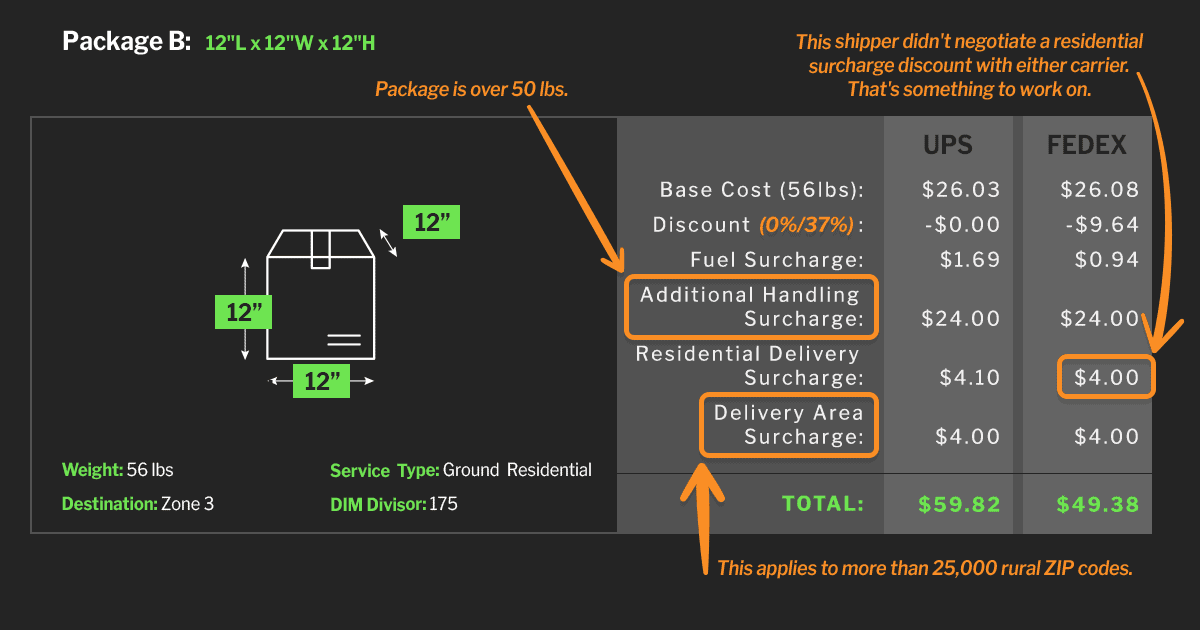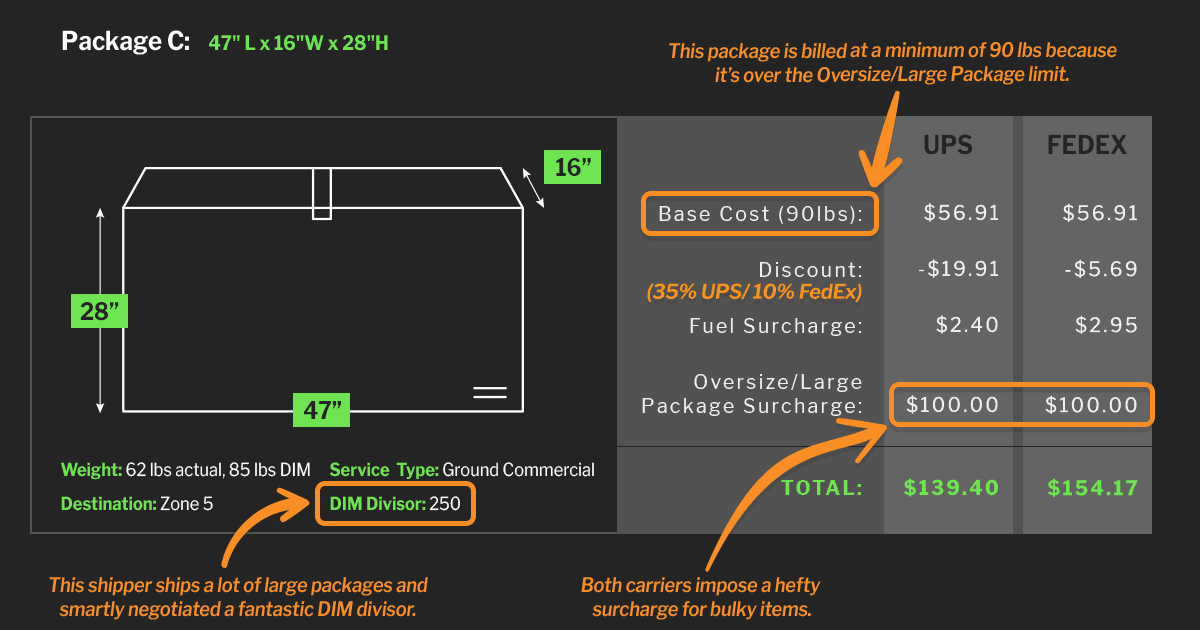A lot of people come to our blog after searching for “UPS vs FedEx rates” or “carrier invoice audits,” looking for answers about how to get shipping costs under control. Everybody wants to find ways to save, of course.
But here’s the kicker: There’s no one-size-fits-all magic wand for getting the best rates or biggest discounts from UPS or FedEx. Carrier pricing is dynamic and different for everyone.
The deal you get with your carrier is almost entirely dependent on your shipping profile: what you ship, where you ship it, the services you use, and many other factors that make your business unique to a carrier.
Yes, the carriers publish rate guides annually, but the amount you actually pay depends on that crucial shipping profile your carrier has built about you — and your ability to understand it yourself.
To see the difference that package weights, earned discounts, contract optimization and more make in your shipping spend, let’s take a look at three fictional packages. We’ll see how different shippers are affected by their profiles.
Package A: DIM Weight and Additional Handling add up

First, this shipper has optimized a competitive UPS discount, but optimization is only half the battle. Your discount is your base (optimized) discount plus your earned discount, which is based on your volume and can disappear without warning if your volume drops off. The shipper doesn’t have a discount with FedEx, meaning they’ll not only pay more, but they could be short on options and flexibility if their UPS relationship isn’t working out.
(Remember: Don’t stress too much over the discount tier you optimize. There are many other factors that affect your spend.)
This shipper could be in for a surprise if they’re not watching their dimensions and staying aware of the impact on their costs. This package was charged a base cost for the dimensional weight (35 lbs) instead of its actual weight (25 lbs). The carrier will always charge you the higher of the two.
Your dimensional weight is calculated by multiplying the length, height and width of the package and dividing that number by the DIM divisor. The standard DIM divisor for both carriers is 139, but did you know you can optimize it? The shipper of Package C does — read on to find out why that matters.
Package B: Surcharges upon surcharges

This shipper has a lower discount with their preferred carrier than the shipper for Package A. It could be that they didn’t optimize a competitive base discount or that they don’t have a strong earned discount because they are a lower-volume shipper. And they don’t have any discount with UPS, again making it hard to switch carriers if necessary.
This package is over the 50-lb threshold for the Additional Handling surcharge, so that adds $24 to the invoice. It was headed to a residential development in a rural area, so it got hit with both the Residential Delivery surcharge and the Delivery Area surcharge. (These often occur on the same package.)
You can’t avoid these surcharges if your customers want their packages shipped to these areas, but you can optimize to lower them. It’s important to understand which surcharges will affect your shipping profile and spend the most and focus on optimizing those.
For instance, this shipper optimized a higher DIM divisor, but, at least for this package it’s not benefitting them because it was charged for its actual weight, not its DIM weight. For this package, it would be better if they had a discount on the residential surcharge. This shipper should examine their shipping data, determine which surcharges affect them most often, and work on optimizing those.
Package C: Oversize means overwhelming costs

Where this shipper really nailed it was their DIM divisor. Remember, the higher your DIM divisor, the lower your DIM weight. They’re clearly experienced at shipping large packages. They probably even expected what many shippers don’t: the 90-lb minimum billable weight that’s automatically triggered when you incur the Oversize (FedEx) or Large Package (UPS) surcharge.
The surcharge itself is hefty ($100 for commercial deliveries and $120 for residential) and comes when a package is longer than 96” or 130” in length plus girth. (Girth is two times the width plus two times the height of the package.) I hope this shipper took this shipping cost into account when they set their free shipping minimum.
What they might not have considered was how their volume was weathering the pandemic. Their FedEx discount is less than it could be — maybe they lost their earned discount when their volume went down.
Know your own data to get the best shipping deals
All these shippers have positive and negative ways that their shipping profiles and their carrier contracts have affected these particular packages.
While you’ll never find a perfect combination of surcharges to optimize to guarantee the lowest rate on every single package, it’s absolutely essential to understand your own profile and data so you can make the best choices for your business and your most common shipment characteristics. That’s how you’ll protect your bottom line in these bumpy times.
Mystified by shipping surcharges? Get the scoop on the five biggest in our eBook, 5 Budget-Busting Surcharges & How to Lower Them.














